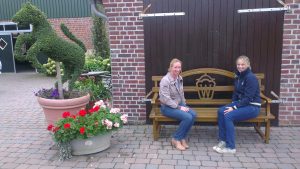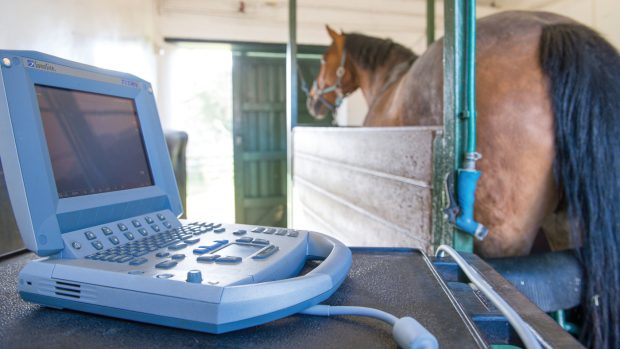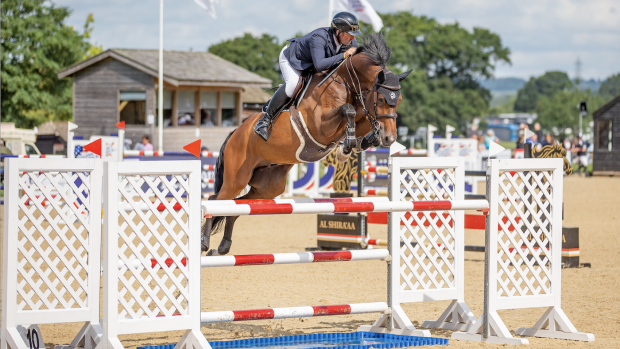Princesses with high school dressage Haflingers, champion young horses, piaffing miniature spotties, a vegetable dash-and-grab, a blinding pony quadrille (is it an octodrille when there are 8 of them?), prize stallions and 50 auction horses presented: the Westfalian society’s (free) gala evening the night before their elite auction is an assault on the senses.
The German studbook fixed up a whole weekend of fun and education all rolled into one at their headquarters. It’s Olympia’s father Christmas routine meets the dressage trainers’ forum. And it works.
While the focus was sport horse breeding, others got a look-in, too. Out came the ponies and the heavy horses. Everyone wanted to adopt the mini spotty who popped unexpectedly out of the back of a little transit van after it had done a few laps of the arena. He was presented in long reins; imagine the tiniest piaffe and pirouettes you’ve ever seen — and with proper self-carriage! Do we have any of these in the UK and, if so, can I request them for our stallion parades?
We saw the 4-year-old breeding stallion Estobar (Escolar/Furst Piccolo) and I was blown away. He’s undoubtedly one of the best young horses I’ve ever seen. Forget fantasy football, my fantasy breeding team puts him and Farouche front and centre.
The finale consisted of two working coldblood horses pulling a giant cart of vegetables into the arena. When the signal was given, there was what can only be described as a pitch invasion and the veg was gone in a second (pictured). One Japanese client proudly held aloft the fennel he had managed to grab; his table weren’t entirely sure what it was. Still, the whole evening was so full of good cheer — aided, I’m sure, by the beermobile that followed the heavy horses into the ring and dished out free booze.
 An accidental quarter-millionaire
An accidental quarter-millionaire
The price highlight of the following day’s elite auction fetched E280,000 (about quarter of a million quid). All winning bidders get a bunch of flowers and these personalised bottles of Westfalian bubbly.
Damon’s Dream, a three-year-old gelding by Damon Hill out of a Furst Heinrich (Farouche’s sire) dam, has swept the board in young horse classes — which start at 3 in Germany, whereas in the UK classes start at 4-year-olds.
As fantastically well organised as sport horse breeding in Germany may be, the MD of the Wesfalian studbook tells a brilliant story about how the bundeschampion (young horse champion) came into being.
The breeders, Jorn Heinrich Hormann and his wife entered a competition to win some semen. The husband had decided on the showjumping stallion he wanted, should he win. But his wife had other ideas and wrote Damon Hill on the entry form. Any remnants of irritation on his part were surely finally eliminated when the gelding went under the hammer. For once it’s not quite so ludicrous to say it: he looked a million dollars.
Turns out, however much forethought you put into these breeding decisions, sometimes the best outcomes arrive from happy accidents.
A united British studbook?
The price highlight at Brightwells’ elite August auction was £42,000 for a Belissimo M/Weltmeyer 4-year-old. As Brits, should we be depressed? That’s a toughie. What does it mean to support British breeding? And how can it be done while also striving to own, ride and breed the best horses?
Only one of our European bronze medal winning team was bred in Britain — Half Moon Delphi. Happily she is still owned by her breeders, the Deverills. The mare is, however, by a German-bred stallion who now stands in Germany (though he is British-owned and was standing in Britain for a long time – boy, this gets complicated).
On the international stage, British breeding is still embryonic and it’s a brave few who put their necks on the line to champion it. But even these bold few are, largely, still passporting their British-breds with foreign based studbooks. Until a British studbook can offer the same opportunities worldwide as a Hanoverian, Oldenburg, KWPN or Westfalian passport, they will probably continue to do so.
What we really need is a unified British sport horse studbook (and not the bonkers 93 or so passport issuers we currently have) that is internationally well enough respected (and World Breeding Federation for Sport Horses-approved, of course) that will keep doors open for our horses as wide as they are for our continental counterparts. And, controversial though it is, I think that studbook should have an easily identifiable new British brand.
A fly on the wall
As a society, the Westfalian (yes, other associations are available, but this is the one I visited) auction system works. As a fly on the wall at this auction — and in the three days preceding it — I saw nothing but open friendliness.
Each year, the horses are selected from many put forward. They are then invited back and reassessed over seven days to better judge their character and temperament. Dodgy horses or those unwilling to work are sent back to whence they came.
What really stood out about the auction collection was the consistent rideability. It’s a big ask for young horses, but they coped well. They were well produced and weren’t shown with their necks cranked up short and high and doing the ‘auction megatrot’.
Spare a thought for the auction house, though. They, like all other auctioneers, are keen to make the most money possible, but imagine a rich client turning up who isn’t the best rider. It’s a tricky situation that needs careful managing. Buyers have a responsibility to ask themselves whether they are up to riding even the more modest-moving young auction horses before blindly climbing on to whichever they fancy, their courage bolstered by the cash in their pocket or an unwise trainer.
I was so impressed here by the invigorating mixture of serious horsemanship, commercial nous, equine education and fun. What a brilliant set-up.







